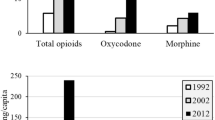Summary
0.5 mg3H-proscillaridin-4-methylether was administered orally to 5 healthy males. Maximum plasma levels of total radioactivity were reached after one to two hours. In two subjects a second peak was observed between 6 and 12 hours. The plasma half life of total radioactivity was 51 hours. 20% and 56% respectively of the dose were eliminated in urine and faeces during the following 7 days. 55% of the total radioactivity in plasma, 80% in urine and 20% in faeces consisted of CHCl3-insoluble compounds. 50 – 60% of the latter in plasma and urine could be hydrolysed by β-glucuronidase. More than 90% of the split products were identified as conjugates of methylproscillaridin. TLC-separation of the CHCl3-soluble fractions of plasma and urine yielded two unidentified metabolites, P2 and P3, as the main compounds, besides methylproscillaridin, proscillaridin and scillarenin. In faeces more than 90% of the non-polar fraction was identified as methylproscillaridin. Shortly after administration of3H-methylproscillaridin, the radioactivity in plasma consisted mainly of CHCl3-in-soluble conjugates and of the metabolite P2.
Similar content being viewed by others
References
Barlow, J.J., Kellie, A.E.: A quantitative method for the chromatographic separation of 17-oxo-steroid sulfates from 17-oxo-steroid glucuronides: with observation on the behaviour of conjugated corticosteroids on the same system. Biochem. J.71 86–91 (1959)
Belz, G.G., Brech, W.J.: Plasmaspiegel und Kumulationsverhalten von Proscillaridin bei Niereninsuffizienz. Klin. Wschr.52 640–644 (1974)
Bulger, W.H., Stohs, S.J., Wheeler, D.M.S.: 6β-Hydroxy-3 epi-digitoxigenin — the major metabolite of digitoxigenin by rabbit liver homogenates. Biochem. Pharmacol.23 921–929 (1974)
Hänel, J., Meiffert, G.: Klinisch experimentelle Studie zur Charakterisierung eines Herzglykosids. Med. Welt17 1404–1408 (1966)
Herrmann, I., Repke, K.: Konjugation von Cardenolidgeninen mit Schwefelsäure und Glucuronsäure. Naunyn-Schmiedebergs Arch. exp. Path. Pharmak.248 370–384 (1964)
Kaiser, F.: Teilsynthetische Herzglykosid — Derivate mit verbesserter enteraler Wirksamkeit. 28. Mitteilung über Herzglykoside. Planta med. (Stuttg.)20 Suppl. 4, 52–60 (1971)
Kesselring, K.: Versuche zur Pharmakokinetik und zum Stoffwechsel von Proscillaridin-4-methyläther (Ky 18). Unveröffentlichte Ergebnisse (1974)
Kubicek, F., Lindner, A., Polzer, K.: Zur Pharmakologie und therapeutischer Anwendung des Proscillaridin A. Wien. Klin. Wschr.77 12–16 (1965)
Kuhlmann, J., Abshagen, U., Rietbrock, N.: Pharmacokinetics and metabolism of digoxigenin — mono — digitoxoside in man. Europ. J. clin. Pharmacol.7 87–94 (1974)
Lauterbach, F., Repke, K.: Die fermentative Abspaltung von D-Digitoxose, D-Cymarose und L-Thevetose aus Herzglykosiden durch Leberschnitte. Naunyn-Schmiedebergs Arch. exp. Path. Pharmak.239 196–218 (1960)
Lüllmann. H., Peters, T.: The cardioactivity of digitoxin metabolites. Europ. J. Pharmacol.14 204–205 (1971)
Meier, G., Wagner, G.: Therapeutische Erfahrungen mit einem neuen Herzglykosid: Proscillaridin A. Med. Welt35 1995–2002 (1965)
Repke, K.: Metabolism of cardiac glycosides. Proc. First Int. Pharmacol. Mtg., Stockholm 1961, Vol. 3 p 47, Oxford: Oxford University Press 1963
Rietbrock, N., Vöhringer, H.-F.: Metabolism and excretion of3H-digitoxin in the rat. Biochem. Pharmacol.23 2567–2575 (1974)
Staud, R., Rietbrock, N., Fassbender, H.-P.: Excretion of methylproscillaridin in patients with biliary fistula. In preparation
Vöhringer, H.-F., Rietbrock, N.: Metabolism and excretion of3H-digitoxin in man. Clin. Pharmacol. Ther.16 796–806 (1974)
Author information
Authors and Affiliations
Additional information
Supported by the Deutsche Forschungsgemeinschaft and by the Knoll AG
Rights and permissions
About this article
Cite this article
Rietbrock, N., Staud, R. Metabolism and excretion of methylproscillaridin by man. Eur J Clin Pharmacol 8, 427–432 (1975). https://doi.org/10.1007/BF00562317
Received:
Accepted:
Issue Date:
DOI: https://doi.org/10.1007/BF00562317




